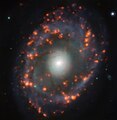NGC 6902
| Galaxie NGC 6902 / IC 4948 | |
|---|---|
 | |
| NGC 6902 aufgenommen durch SPECULOOS[1] | |
| AladinLite | |
| Sternbild | Schütze |
| Position Äquinoktium: J2000.0, Epoche: J2000.0 | |
| Rektaszension | 20h 24m 28,1s[2] |
| Deklination | −43° 39′ 13″[2] |
| Erscheinungsbild | |
| Morphologischer Typ | SA(r)b / LINER[3] |
| Helligkeit (visuell) | 10,9 mag[3] |
| Helligkeit (B-Band) | 11,8 mag[3] |
| Winkelausdehnung | 5,6′ × 3,9′[3] |
| Positionswinkel | 153°[3] |
| Flächenhelligkeit | 14.1 mag/arcmin²[3] |
| Physikalische Daten | |
| Zugehörigkeit | SSRS Gruppe 37 NGC 6902-Gruppe LGG 434[2][4] |
| Rotverschiebung | 0,009326 ± 0,000013[2] |
| Radialgeschwindigkeit | (2796 ± 4) km/s[2] |
| Hubbledistanz H0 = 73 km/(s • Mpc) | (125 ± 9) · 106 Lj (38,2 ± 2,7) Mpc [2] |
| Geschichte | |
| Entdeckung | John Herschel |
| Entdeckungsdatum | 2. September 1836 |
| Katalogbezeichnungen | |
| NGC 6902 • IC 4948 • PGC 64632 • ESO 285-008 • MCG -07-42-002 • IRAS 20210-4348 • 2MASX J20242813-4339127 • SGC 202102-4348.9 • AM 2021-434 • GALEXMSC J202427.84-433915.5 • LDCE 1394 NED004 | |
NGC 6902 = IC 4948 ist eine Balken-Spiralgalaxie mit aktivem Galaxienkern vom Hubble-Typ SBa im Sternbild Schütze auf der Ekliptik. Sie ist schätzungsweise 125 Millionen Lichtjahre von der Milchstraße entfernt und hat einen Durchmesser von etwa 210.000 Lichtjahren.
Gemeinsam mit IC 4946 und PGC 64580 (NGC 6902B) bildet sie die kleine NGC 6902-Gruppe oder LGG 434.
Das Objekt wurde am 2. September 1836 vom britischen Astronomen John Herschel entdeckt (als NGC-Objekt aufgeführt).[5]
NGC 6902-Gruppe (LGG 434)
| Galaxie | Alternativname | Entfernung/Mio. Lj |
|---|---|---|
| NGC 6902 | PGC 64632 | 125 |
| IC 4946 | PGC 64614 | 129 |
| PGC 64580 | NGC 6902B | 132 |
Weblinks
Einzelnachweise
Auf dieser Seite verwendete Medien
Autor/Urheber: (Credit) ESO/TIMER survey, Lizenz: CC BY 4.0
Zooming in on Star Formation
Discovered in the year 1836 by John Herschel, NGC 6902 is a beautiful spiral galaxy located more than 130 million light-years away in the constellation of Sagittarius, the Archer. This image was taken with MUSE, the Multi Unit Spectroscopic Explorer instrument attached to one of the four 8.2-metre telescopes that make up the VLT, and shows the galaxy from a unique perspective. A zoom in towards the galaxy’s centre, the image shows a nuclear ring where the orange glow of intense star formation is visible.
Inside this ring lies a faint and small bar of stars. Researchers found that stars within it are distributed differently depending on their age, with younger stars aligned along the bar and older stars more dispersed. These locations of the young and old stars within the central bar of NGC 6902 confirm predictions made years earlier from simulations and models. This is the first time these predictions of galactic structure were confirmed with observations thanks to the incredible spatial resolution of the MUSE instrument.
Credit:
ESO/TIMER survey
Coordinates Position (RA): 20 24 28.17 Position (Dec): -43° 39' 13.25" Field of view: 1.06 x 1.09 arcminutes Orientation: North is 0.1° right of vertical
Colours & filters Band Telescope Optical B 438 nm Very Large Telescope MUSE Optical g 475 nm Very Large Telescope MUSE Optical r 625 nm Very Large Telescope MUSE Optical H-alpha 656 nm Very Large Telescope MUSE Optical N II 658 nm Very Large Telescope MUSE.
NGC 6902 galaxy by GALEX
Autor/Urheber: ESO, Lizenz: CC BY 4.0
NGC 6902 Caught by SPECULOOS
This Picture of the Week is a special treat: a first-light image from the newest resident of ESO’s Paranal Observatory, the SPECULOOS Southern Observatory. This planet-hunting machine aims to observe nearby but dim stars to locate exoplanets for other telescopes — such as ESO’s forthcoming Extremely Large Telescope (ELT) — to study in detail. Comprising four one-metre telescopes, each named after one of Jupiter’s Galilean moons, SPECULOOS promises to open up new frontiers in exoplanet research.
This image, however, is obviously not of a faint star, but of a galaxy called NGC 6902. Before a telescope starts its primary mission it must successfully undertake an event called “first light”: the first time it is used for a scientific observation. Astronomers typically pick well-known objects for this initial test of a telescope’s capabilities, which is half demonstration and half celebration. In this case, the team settled on NGC 6902 as the first-light target for the Ganymede telescope.
The result was this stunning image of the spiral galaxy, which is found about 120 million light-years from Earth in the constellation of Sagittarius (The Archer). The galaxy’s spiral arms swirl outwards from a bright centre until they dissolve into streams of blue haze at the galaxy’s edge. If this is what Ganymede can produce as its first observation of something it wasn’t even designed to image, we have a lot to look forward to. Watch this space!
Credit:
ESO
Coordinates Position (RA): 20 24 28.51 Position (Dec): -43° 39' 3.59" Field of view: 10.62 x 10.64 arcminutes Orientation: North is 0.2° left of vertical.




